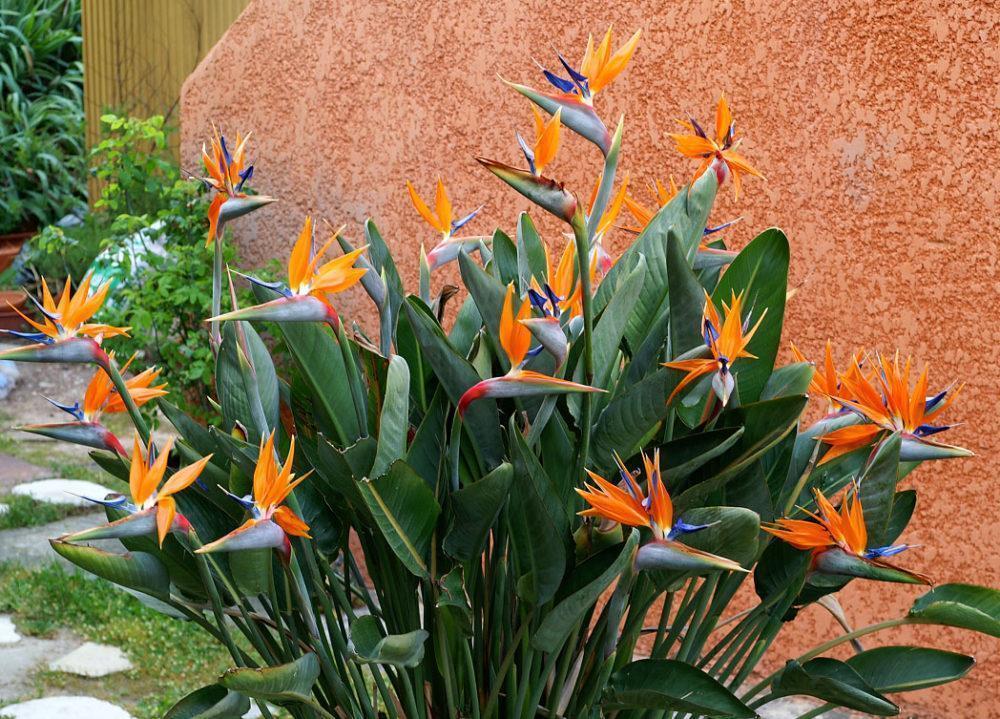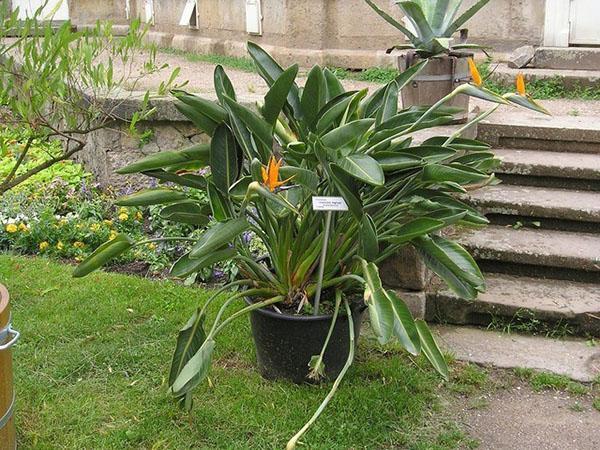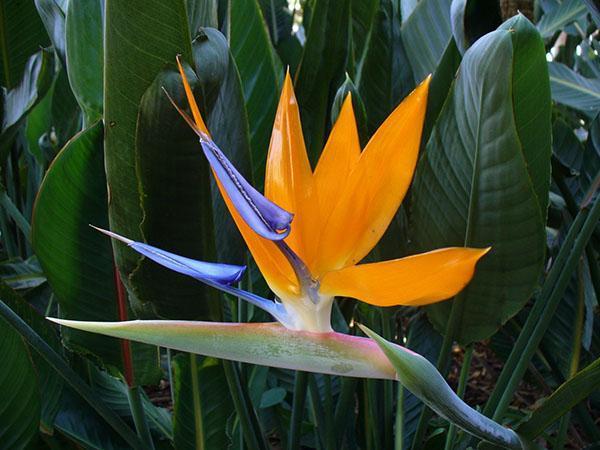Description of types of ornamental plant strelitzia
 The active exploration of the world and its previously inaccessible corners gave man a meeting with the most amazing plants. Among them is strelitzia, the description and types of which became available to botanists at the turn of the 19th century.
The active exploration of the world and its previously inaccessible corners gave man a meeting with the most amazing plants. Among them is strelitzia, the description and types of which became available to botanists at the turn of the 19th century.
A small genus of Strelitzia or Strelitzia comes from South Africa, where these rather large perennials prefer to settle on sunny dry plateaus, as well as in transparent shade under large trees. Travelers who were exploring distant lands could not help but notice plants with bright, hard inflorescences, shaped like the heads of outlandish birds of paradise. First, the strelitzia were "domesticated" by immigrants from Europe, and then from southern Africa they came to the Old World.
The flower was named in honor of Charlotte-Sophia of Mecklenburg-Strelitzkaya. So the botanists of Great Britain not only flattered their queen, but also expressed their gratitude to her for her interest in science and the opening of the largest, existing botanical garden in Kew.
Description of Strelitzia
All strelitzia known today are large evergreen perennials with a powerful aboveground part and the same root system. Thanks to taproots, the plant is perfectly adapted to a lack of moisture. The leaves of some strelitzia species resemble banana ones, but in arid regions, the leaf plates of local varieties shrink, become like an oar, or disappear altogether, turning the plant into a kind of giant, waxy bloom of curled porcupine. Strelitzia is adorned with its inflorescences, combining from 5 to 7 orange-purple flowers.
 The largest strelitzia, according to the descriptions of the species, reach 10 meters in height. For growing in a room, nurseries of the Republic of South Africa, Australia and other countries choose more compact varieties and are actively engaged in breeding work to obtain original varieties and dwarf plants.
The largest strelitzia, according to the descriptions of the species, reach 10 meters in height. For growing in a room, nurseries of the Republic of South Africa, Australia and other countries choose more compact varieties and are actively engaged in breeding work to obtain original varieties and dwarf plants.
Royal Strelitzia (Strelitzia reginae)
 The first of the discovered and described types of strelitzia also received the monarch's name. The plant, native to southern Africa, quickly became popular not only in Europe, but also in the New World. Los Angeles has officially made the flower its living symbol. And unpretentious royal strelitzia reciprocate with the townspeople and delight with unusual flowering for a very long time.
The first of the discovered and described types of strelitzia also received the monarch's name. The plant, native to southern Africa, quickly became popular not only in Europe, but also in the New World. Los Angeles has officially made the flower its living symbol. And unpretentious royal strelitzia reciprocate with the townspeople and delight with unusual flowering for a very long time.
The crown of a plant in a potted culture reaches a height of 1–1.5 meters. Oval or slightly tapering leaves, 40 cm long and up to 30 cm wide, are arranged in two rows, have a smooth surface, smooth edges and a long hard petiole that grows up to 60 cm. A powerful rhizome is hidden under the soil, with which the flower can be propagated.
 The inflorescences, partially hidden by tough greenish-brown bracts, consist of several flowers with orange and blue-violet petals. With proper care, the size of one flower reaches 10-15 cm, and spring bloom may be followed by another. According to the description, strelitzia may not fade for up to a month, while the flowers behave just as steadily when cut.
The inflorescences, partially hidden by tough greenish-brown bracts, consist of several flowers with orange and blue-violet petals. With proper care, the size of one flower reaches 10-15 cm, and spring bloom may be followed by another. According to the description, strelitzia may not fade for up to a month, while the flowers behave just as steadily when cut.
Choosing a royal strelitzia in the store, you can see another name - small-leaved strelitzia or Strelitzia Parvifolia. They are one and the same crop, considered the best for home growing.
 To diversify the collections of florists, the Mandela Gold variety was bred in South Africa with yellow-blue flowers unusual for wild plants and two-time flowering.
To diversify the collections of florists, the Mandela Gold variety was bred in South Africa with yellow-blue flowers unusual for wild plants and two-time flowering.
Strelitzia nicolai
 Strelitzia can rightfully be called a royal flower. Not only did the entire genus and the first of the species receive the name of the British queen, another variety of the flower began to be named in honor of Grand Duke Nikolai Nikolaevich, who was fascinated by the flora and supervised the St. Petersburg Botanical Garden.
Strelitzia can rightfully be called a royal flower. Not only did the entire genus and the first of the species receive the name of the British queen, another variety of the flower began to be named in honor of Grand Duke Nikolai Nikolaevich, who was fascinated by the flora and supervised the St. Petersburg Botanical Garden.
As follows from the description, this species of strelitzia can rightfully be attributed to the largest greenhouse plants. Therefore, it is not surprising that birds are pollinators in nature, and in a potted culture, the flower has to be manually pollinated.
The plants growing up to 10 meters in height look like a banana, which influenced the appearance of the popular name Strelitzia. Long wild banana leaves on powerful stalks are actively used by the population for making hedges, ropes, and roofing.
 In spring, the trunks, more like palm trees, are decorated with white-blue inflorescences in purple, greenish-red, rigid stipules.
In spring, the trunks, more like palm trees, are decorated with white-blue inflorescences in purple, greenish-red, rigid stipules.
Mountain strelitzia (Strelitzia caudata)
 Another large type of strelitzia is mountain. In size, it boldly competes with the trees of the rainforest. The herbaceous perennial can grow up to 10 meters in height. As it grows, the lower part of the trunk is exposed, making the plant look like a regular banana or even a palm tree.
Another large type of strelitzia is mountain. In size, it boldly competes with the trees of the rainforest. The herbaceous perennial can grow up to 10 meters in height. As it grows, the lower part of the trunk is exposed, making the plant look like a regular banana or even a palm tree.
 Like the previously described variety, the flowers of the mountain strelitzia are composed of white and blue inner petals. Corollas accreted from below are combined in several pieces and covered with reddish or dark purple stipules up to half a meter long.
Like the previously described variety, the flowers of the mountain strelitzia are composed of white and blue inner petals. Corollas accreted from below are combined in several pieces and covered with reddish or dark purple stipules up to half a meter long.
Strelitzia reed (Strelitzia juncea)
 This type of strelitzia, according to the description, is very different from the large varieties. And it's not only a more modest size, but also the appearance of the plant. The desert species from the east of South Africa is perfectly adapted to a long dry period and, unlike other strelitzia, tolerates a drop in temperature to light frosts well.
This type of strelitzia, according to the description, is very different from the large varieties. And it's not only a more modest size, but also the appearance of the plant. The desert species from the east of South Africa is perfectly adapted to a long dry period and, unlike other strelitzia, tolerates a drop in temperature to light frosts well.
 The orange-purple flowers of the reed strelitzia are very reminiscent of the flowering of the royal variety. However, the appearance of the foliage will not allow these plants to be confused. A dense rosette is formed by elongated, waxy bloom leaves-needles, completely devoid of leaf plates and growing to a length of 1.5–2 meters.
The orange-purple flowers of the reed strelitzia are very reminiscent of the flowering of the royal variety. However, the appearance of the foliage will not allow these plants to be confused. A dense rosette is formed by elongated, waxy bloom leaves-needles, completely devoid of leaf plates and growing to a length of 1.5–2 meters.
Due to the great demand from florists from all over the world, in nature, the strelitzia species, described above, is endangered. For flower propagation, nurseries use bioculture, vegetative methods and artificial pollination to obtain seeds.
Strelitzia white (Strelitzia alba)
 In the Cape region, you can see wild plants of another well-known species. They are large, with a partially lignified stem and long elliptical leaves of white or Augustus strelitzia. Once a year, original inflorescences of white flowers appear from the axils of the leaves, for the time being hidden in purple lanceolate bracts.
In the Cape region, you can see wild plants of another well-known species. They are large, with a partially lignified stem and long elliptical leaves of white or Augustus strelitzia. Once a year, original inflorescences of white flowers appear from the axils of the leaves, for the time being hidden in purple lanceolate bracts.
 Flowering lasts from May to mid-summer, until the petals up to 15-18 cm long wither to give life to the fruit-boxes ripening at the end of winter. Like the reed strelitzia, its larger relative also needs human protection and is included in the Red Book of South African Plants.
Flowering lasts from May to mid-summer, until the petals up to 15-18 cm long wither to give life to the fruit-boxes ripening at the end of winter. Like the reed strelitzia, its larger relative also needs human protection and is included in the Red Book of South African Plants.